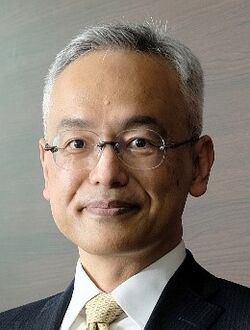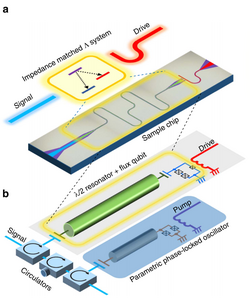Biography:Yasunobu Nakamura
Yasunobu Nakamura | |
|---|---|
 Yasunobu Nakamura | |
| Born | 1968 Osaka, Japan[1] |
| Known for | Work with "hybrid quantum information systems".[2][3] First demonstration of coherent control of a Cooper pair box-based superconducting charge qubit.[4][5] |
| Awards | Micius Quantum Prize 2021 |
| Scientific career | |
| Fields | Quantum information science, Superconducting quantum computing |
Yasunobu Nakamura (中村 泰信 Nakamura Yasunobu) is a Japanese physicist. He is a professor at the University of Tokyo's Research Center for Advanced Science and Technology (RCAST)[6] and the Principal Investigator of the Superconducting Quantum Electronics Research Group (SQERG) at the Center for Emergent Matter Science (CEMS) within RIKEN.[7] He has contributed primarily to the area of quantum information science,[8] particularly in superconducting quantum computing and hybrid quantum systems.[9][10][11]
Education and early work
While a child, Nakamura's family moved from Osaka to Hinode, Tokyo, where he would gain his early education.[12] He obtained his Bachelor of Science (1990), Master of Science (1992), and Ph.D. (2011) degrees at the University of Tokyo. In 1999, as a researcher at NEC, Nakamura and collaborators Yuri Pashkin and Jaw-Shen Tsai demonstrated "electrical coherent control of a qubit in a solid-state electronic device"[4] and in 2001 "realized the first measurement of the Rabi oscillations associated with the transition between two Josephson levels in the Cooper pair box"[13][14] in a configuration developed by Michel Devoret and colleagues in 1998.[13][15]
In 2000, Nakamura was featured as a "Younger Scientist" by the Japan Society of Applied Physics for his work at NEC in "quantum-state control of nanoscale superconducting devices."[16] From 2001-2002, he visited the group of Hans Mooij (de) at TU Delft on a sabbatical from NEC, where he worked with Irinel Chiorescu, Kees Harmans, and Mooij to create the first flux qubit.[17][18][19] In 2003, he was named one of MIT Technology Review's top innovators under 35 years old, in which editors noted that "Nakamura and a collaborator got two qubits to interact in a manner that had been predicted but never demonstrated" at the time.[20]
Current work
(As of October 2016), the Japan Science and Technology Agency (科学技術振興機構) announced funding for Nakamura's work through their Exploratory Research for Advanced Technology (ERATO) program.[21] The project, entitled Macroscopic Quantum Machines,[22] seeks to dramatically improve quantum state control technology to further the field of quantum computing. Of principal focus is the development of a highly scalable platform for implementing quantum information processing techniques, as well as the creation of hybrid quantum systems which interface with microwave quantum optics. In an article in Nikkei Science (ja) in 2018, it was announced that work towards the construction of a quantum computer with 100 superconducting qubits was underway.[23] In 2019, the Japanese Ministry of Education, Culture, Sports, Science and Technology launched a quantum technology project known as QLEAP, with Nakamura as the team leader for the quantum information processing component.[24] The project aims to develop superconducting quantum computers and other quantum technologies over a ten-year period, by increasing collaboration between academia and industry.

In past years, Nakamura and collaborators have published their findings on the efficient detection of single microwave frequency photons,[25] the suppression of quasiparticles in superconducting quantum computing environments for the improvement of qubit coherence times,[26] the development of "a deterministic scheme to generate maximal entanglement between remote superconducting atoms, using a propagating microwave photon as a flying qubit",[27] and the realization of a hybrid quantum system by the strong, coherent coupling between a collective magnetic mode of a ferromagnetic sphere and a superconducting qubit.[2]
More recently, results have been published in which superconducting qubits were used to resolve quanta of magnon number states,[28][29] to create a quantitatively non-classical photon number distribution,[30] to measure fluctuations in a surface acoustic wave (SAW) resonator,[31] and to measure an itinerant microwave photon in a quantum nondemolition (QND) detection experiment.[32][33] A superconducting circuit was later used to realize information-to-work conversion by a Maxwell's demon,[34] radio waves and optical light were optomechanically coupled to surface acoustic waves,[35] and an ordered vortex lattice in a Josephson junction array was observed.[36]
Nakamura has spoken several times at quantum information science conferences and seminars, including at the University of Vienna,[37] the Institute for Theoretical Atomic Molecular and Optical Physics at Harvard University,[38][39] the National Center of Competence in Research's Quantum Science and Technology Monte Verità conference,[40] the Institute for Quantum Computing at the University of Waterloo,[41] the Institute for Molecular Engineering at the University of Chicago[42] the Institute for Quantum Optics and Quantum Information (IQOQI),[43] and the Yale Quantum Institute at Yale University.[44]
In 2020, Nakamura was named as a fellow of the American Physical Society for "the first demonstration of coherent time-dependent manipulation of superconducting qubits, and for contributions to the development of superconducting quantum circuits, microwave quantum optics, and hybrid quantum systems".[45]
Honors and awards
- 1999 – Young Investigator Award, Japan Society of Applied Physics[46]
- 1999 – The 1st Sir Martin Wood Prize for Japan[47][48]
- 1999 – The 45th Nishina Memorial Prize[49]
- 2003 – TR100, MIT Technology Review[20]
- 2004 – Agilent Technologies Europhysics Prize (with Michel Devoret, Daniel Esteve, and Hans Mooij)[50]
- 2008 – Simon Memorial Prize (with Jaw-Shen Tsai)[51]
- 2014 – The 11th Leo Esaki Prize (ja) (with Jaw-Shen Tsai)[52]
- 2018 - The 19th JSAP Outstanding Achievement Award[53][54]
- 2020 - American Physical Society (APS) Fellow[45]
References
- ↑ "RIKEN Tuning Into Quantum Computers". 2007-08-17. http://www.riken.jp/en/research/rikenresearch/highlights/4986/.
- ↑ 2.0 2.1 Y. Tabuchi, S. Ishino, A. Noguchi, T. Ishikawa, R. Yamazaki, K. Usami, and Y. Nakamura, "Coherent coupling between a ferromagnetic magnon and a superconducting qubit", Science 349, 405-408 (2015), doi:10.1126/science.aaa3693
- ↑ Y. Tabuchi, S. Ishino, T. Ishikawa, R. Yamazaki, K. Usami, and Y. Nakamura, "Hybridizing Ferromagnetic Magnons and Microwave Photons in the Quantum Limit", Physical Review Letters 113, 083603 (2014), doi:10.1103/PhysRevLett.113.083603, arxiv:1405.1913
- ↑ 4.0 4.1 Y. Nakamura, Yu. A. Pashkin and J.- S. Tsai, "Coherent control of macroscopic quantum states in a single-Cooper-pair box", Nature 398, 786-788 (1999), doi:10.1038/19718, arXiv:9904003
- ↑ T. Yamamoto, Yu. A. Pashkin, O. Astafiev, Y. Nakamura, and J.- S. Tsai, "Demonstration of conditional gate operation using superconducting charge qubits", Nature 425, 941-944 (2003), doi:10.1038/nature02015, arxiv:0311067
- ↑ "Research Groups". http://www.ap.t.u-tokyo.ac.jp/en/research.html.
- ↑ "Superconducting Quantum Electronics Research Group". https://www.riken.jp/en/research/labs/cems/superconduct_qtm_electron/.
- ↑ T. D. Ladd, F. Jelezko, R. Laflamme, Y. Nakamura, C. Monroe, and J.L. O'Brien, "Quantum computers", Nature 464, 45-53 (2010), doi:10.1038/nature08812, arxiv:1009:2267
- ↑ "マイナビニュース". 2015-07-10. http://news.mynavi.jp/news/2015/07/10/500/.
- ↑ "ようこそ量子 Interview". 2016-11-15. http://www.ryosi.com/qis/201611/01/.
- ↑ "Science Daily 2015". 2015-08-03. https://www.sciencedaily.com/releases/2015/08/150803105119.htm.
- ↑ "UTokyo Voices 066". 2019-06-20. https://www.u-tokyo.ac.jp/focus/en/features/voices066.html.
- ↑ 13.0 13.1 "Bell Prize 2013". http://cqiqc.physics.utoronto.ca/bell_prize/devoret_schoelkopf.html.
- ↑ Y. Nakamura, Y.A. Pashkin, and J.S. Tsai, "Rabi Oscillations in a Josephson-Junction Charge Two-Level System", Physical Review Letters 87, 246601 (2001), doi:10.1103/PhysRevLett.87.246601
- ↑ V. Bouchiat, D. Vion, P. Joyez, D. Esteve and M. H. Devoret, "Quantum coherence with a single Cooper pair", Physica Scripta T76, 165-170 (1998), doi:10.1238/Physica.Topical.076a00165
- ↑ "JSAP Younger Scientists". https://www.jsap.or.jp/jsapi/Pdf/Number02/YoungerScientists.pdf.
- ↑ I. Chiorescu, Y. Nakamura, C. J. P. M. Harmans, and J. E. Mooij, "Coherent Quantum Dynamics of a Superconducting Flux Qubit", Science 299, 5614, 1869-1871, (2003), doi:10.1126/science.1081045, arxiv:0305461
- ↑ J. Clarke, "Flux Qubit Completes the Hat Trick", Science 299, 5614, 1850-1851, (2003), doi:10.1126/science.1083001
- ↑ "The first Delft qubit". 2017-11-04. http://blog.qutech.nl/index.php/2017/11/04/the-first-delft-qubit/.
- ↑ 20.0 20.1 "Innovators Under 35". http://www2.technologyreview.com/tr35/profile.aspx?TRID=414.
- ↑ "戦略的創造研究推進事業における". http://www.jst.go.jp/pr/info/info1218/index.html.
- ↑ "研究総括および研究領域". https://www.jst.go.jp/pr/info/info1218/shiryou1.html.
- ↑ "超電導量子ビットを創始 100ビットを目指す". September 2018. http://www.nikkei-science.com/201809_008.html.
- ↑ "光・量子飛躍フラッグシッププログラム(Q-LEAP)". https://www.jst.go.jp/stpp/q-leap/index.html.
- ↑ 25.0 25.1 K. Inomata, Z. Lin, K. Koshino, W. D. Oliver, J.- S. Tsai, T. Yamamoto, and Y. Nakamura, "Single microwave-photon detector using an artificial Λ-type three-level system", Nature Communications 7, 12303 (2016), doi:10.1038/ncomms12303
- ↑ S. Gustavsson, F. Yan, G. Catelani, J. Bylander, A. Kamal, J. Birenbaum, D. Hover, D. Rosenberg, G. Samach, A. P. Sears, S. J. Weber, J. L. Yoder, J. Clarke, A. J. Kerman, F. Yoshihara, Y. Nakamura, T. P. Orlando, and W. D. Oliver, "Suppressing relaxation in superconducting qubits by quasiparticle pumping", Science 354, 6319, 1573-1577 (2016), doi:10.1126/science.aah5844
- ↑ K. Koshino, K. Inomata, Z. R. Lin, Y. Tokunaga, T. Yamamoto, and Y. Nakamura, "Theory of Deterministic Entanglement Generation between Remote Superconducting Atoms", Physical Review Applied 7, 064006 (2017), doi:10.1103/PhysRevApplied.7.064006
- ↑ D. Lachance-Quiriom, Y. Tabuchi, S. Ishino, A. Noguchi, T. Ishikawa, R. Yamazaki, and Y. Nakamura, "Resolving quanta of collective spin excitations in a millimeter-sized ferromagnet", Science Advances 3, 7, e1603150 (2017), doi:10.1126/sciadv.1603150
- ↑ "Quantifying quanta". 2017-11-22. https://www.u-tokyo.ac.jp/focus/en/articles/a_00582.html.
- ↑ S. Kono, Y. Masuyama, T. Ishikawa, Y. Tabuchi, R. Yamazaki, K. Usami, K. Koshino, and Y. Nakamura, "Nonclassical Photon Number Distribution in a Superconducting Cavity under a Squeezed Drive", Physical Review Letters 119, 023602 (2017), doi:10.1103/PhysRevLett.119.023602
- ↑ A. Noguchi, R. Yamazaki, Y. Tabuchi, and Y. Nakamura, "Qubit-Assisted Transduction for a Detection of Surface Acoustic Waves near the Quantum Limit", Physical Review Letters 119, 180505 (2017), doi:10.1103/PhysRevLett.119.180505
- ↑ S. Kono, K. Koshino, Y. Tabuchi, A. Noguchi, and Y. Nakamura, "Quantum non-demolition detection of an itinerant microwave photon", Nature Physics 14, 546-549 (2018), doi:10.1038/s41567-018-0066-3
- ↑ "Viewpoint: Single Microwave Photons Spotted on the Rebound". 2018-04-23. https://physics.aps.org/articles/v11/38.
- ↑ Y. Masuyama, K. Funo, Y. Murashita, A. Noguchi, S. Kono, Y. Tabuchi, R. Yamazaki, M. Ueda, and Y. Nakamura, "Information-to-work conversion by Maxwell’s demon in a superconducting circuit quantum electrodynamical system", Nature Communications 9, 1291 (2018), doi:10.1038/s41467-018-03686-y
- ↑ A. Okada, F. Oguro, A. Noguchi, Y. Tabuchi, R. Yamazaki, K. Usami, and Y. Nakamura, "Cavity Enhancement of Anti-Stokes Scattering via Optomechanical Coupling with Surface Acoustic Waves", Physical Review Applied 10, 024002 (2018), doi:10.1103/PhysRevApplied.10.024002
- ↑ R. Cosmic, K. Ikegami, Z. Lin, K. Inomata, J. M. Taylor, and Y. Nakamura, "Circuit-QED-based measurement of vortex lattice order in a Josephson junction array", Physical Review B 98, 060501(R) (2018), doi:10.1103/PhysRevB.98.060501
- ↑ "University of Vienna 2014". https://physik.univie.ac.at/en/wpk/wpk-detail/archive/2014/june//article/yasunobu-nakamura-research-center-for-advanced-science-and-technology-the-university-of-tokyo/?tx_ttnews%5BbackPid%5D=146952&cHash=133067e9dc3db92ea3243fede2bb6e1c.
- ↑ "ITAMP". https://www.cfa.harvard.edu/itamp/LightMatterInteractionsinLowDimensions-schedule.html.
- ↑ "ITAMP Video". 2015-07-15. https://www.youtube.com/watch?v=CrjkLcimTX4.
- ↑ "NCCR QSIT". http://www.nccr-qsit.ethz.ch/news/conferences-events/monte-verita-2015/invited-speakers.html.
- ↑ "IQC 2016". https://uwaterloo.ca/institute-for-quantum-computing/events/seminar-yasunobu-nakamura.
- ↑ "IME Distinguished Colloquium Series". https://ime.uchicago.edu/events/4549/.
- ↑ "IQOQI Colloquium". https://www.iqoqi.at/en/current/gallery/2018/03102018-6th-iqoqi-colloquium-yasunobu-nakamura.
- ↑ "YQI Colloquium". https://quantuminstitute.yale.edu/event/yqi-colloquium-yasunobu-nakamura-university-tokyo.
- ↑ 45.0 45.1 "APS Fellows". https://www.aps.org/programs/honors/fellowships/archive-all.cfm?initial=N.
- ↑ "JSAP Younger Scientists". https://www.jsap.or.jp/jsapi/Pdf/Number02/YoungerScientists.pdf.
- ↑ "Prize Winners". http://www.msforum.jp/en/about_sir_martin/prize_winners/.
- ↑ "2016 Sir Martin Wood Prize for Japan". https://www.oxford-instruments.com/businesses/nanotechnology/nanoscience/sir-martin-wood-prize/2016-sir-martin-wood-prize-for-japan.
- ↑ "NEC Awards FY1999". http://www.nec.com/en/global/rd/philosophy/award/1999_awardback.html.
- ↑ "Agilent Technologies Prize". 2004-06-17. http://www.nec.co.jp/press/en/0406/1701.html.
- ↑ "Simon Memorial Prize: Past Winners". http://www.iop.org/activity/groups/subject/lt/prize/page_44359.html.
- ↑ "RCAST News". 2014. http://www.rcast.u-tokyo.ac.jp/research/report/2014/0902_en.html.
- ↑ "JSAP Outstanding Achievement Award Recipients". https://www.jsap.or.jp/english/awards/outstanding-achievement-award/recipients.
- ↑ "第19回 応用物理学会業績賞". https://www.jsap.or.jp/outstanding-achievement-award/recipients/recipients19.
 |

